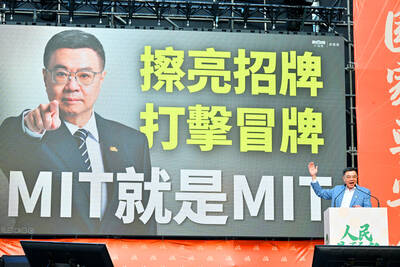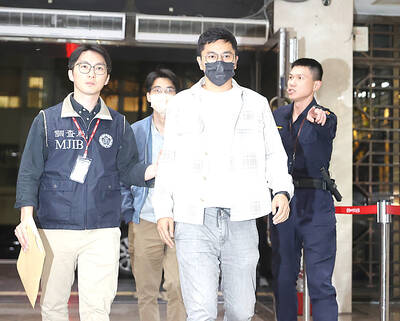Tibet’s exiled spiritual leader the Dalai Lama headed for the US yesterday and a long-awaited meeting with US President Barack Obama that has infuriated China.
For the Dalai Lama — vilified by Beijing as a “wolf in monk’s robes” — recognition by the White House is crucial to maintaining a critical international spotlight on Chinese treatment of his Himalayan homeland.
The Obama administration has stressed that the president is receiving the Dalai Lama as a spiritual rather than political leader, and the meeting will take place in the White House Map Room and not the Oval Office.
But such diplomatic nuances will do little to dampen the Tibetan’s enthusiasm and are not expected to mollify Chinese anger.
“The most important thing is that the meeting is taking place,” the Dalai Lama’s spokesman Tenzin Taklha said before leaving India with the Buddhist leader.
Dismissing Beijing’s denunciation of the White House get-together as “routine rhetoric,” Taklha said the Chinese government’s real concern was having the Tibet issue highlighted.
“No matter what China says, China cares about international opinion,” he said. “The president’s meeting with His Holiness is an expression of the international community’s concern and it sends a strong signal to the Chinese that they need to work with us to reach a solution.”
Obama had avoided a meeting with the Dalai Lama last year in hopes of starting off his relationship on a good foot with China.
It was the first time since 1991 that a US president had declined to host the exiled Tibetan leader during one of his occasional trips to Washington.
Today’s meeting comes at a delicate time for China-US ties amid a row over US arms sales to Taiwan, Beijing’s dispute with Google and trade and currency disagreements.
The Dalai Lama fled to India in 1959 after a failed uprising against Chinese rule in Tibet. He denies China’s assertion that he wants independence for Tibet, insisting he is looking only for “meaningful autonomy.”
Taklha said the Nobel peace laureate would brief Obama on the situation in Tibet and the latest talks between his envoys and the Chinese authorities.
Talks in China last month — the first between the two sides since 2008 — marked the ninth round of a dialogue that has yielded no tangible progress in eight years.
Many observers believe the Chinese are simply stringing the Tibetan exiles along until the Dalai Lama dies, on the assumption that the Tibetan movement will wither without him.
“The Dalai Lama and the people around him have refused to realize this and that the talks have a strategic value for China,” said Elliot Sperling, an expert on Tibet at Indiana University, in the US.
“They’re useful for thwarting criticisms as to why the Chinese government isn’t talking to the Dalai Lama,” Sperling said.
In the absence of any movement in direct negotiations, White House support for the Dalai Lama and the leverage that brings assumes even more importance.
And the Dalai Lama’s secretary Chhime Chhoekyapa said it also sent a comforting signal to those living in Tibet.
“They will feel encouraged that the president of the United States, a global superpower, is meeting with His Holiness. It means the world has not forgotten them,” Chhoekyapa said.

Seventy percent of middle and elementary schools now conduct English classes entirely in English, the Ministry of Education said, as it encourages schools nationwide to adopt this practice Minister of Education (MOE) Cheng Ying-yao (鄭英耀) is scheduled to present a report on the government’s bilingual education policy to the Legislative Yuan’s Education and Culture Committee today. The report would outline strategies aimed at expanding access to education, reducing regional disparities and improving talent cultivation. Implementation of bilingual education policies has varied across local governments, occasionally drawing public criticism. For example, some schools have required teachers of non-English subjects to pass English proficiency

‘FORM OF PROTEST’: The German Institute Taipei said it was ‘shocked’ to see Nazi symbolism used in connection with political aims as it condemned the incident Sung Chien-liang (宋建樑), who led efforts to recall Democratic Progressive Party (DPP) Legislator Lee Kun-cheng (李坤城), was released on bail of NT$80,000 yesterday amid an outcry over a Nazi armband he wore to questioning the night before. Sung arrived at the New Taipei City District Prosecutors’ Office for questioning in a recall petition forgery case on Tuesday night wearing a red armband bearing a swastika, carrying a copy of Adolf Hitler’s Mein Kampf and giving a Nazi salute. Sung left the building at 1:15am without the armband and apparently covering the book with a coat. This is a serious international scandal and Chinese

TRADE: The premier pledged safeguards on ‘Made in Taiwan’ labeling, anti-dumping measures and stricter export controls to strengthen its position in trade talks Products labeled “made in Taiwan” must be genuinely made in Taiwan, Premier Cho Jung-tai (卓榮泰) said yesterday, vowing to enforce strict safeguards against “origin laundering” and initiate anti-dumping investigations to prevent China dumping its products in Taiwan. Cho made the remarks in a discussion session with representatives from industries in Kaohsiung. In response to the US government’s recent announcement of “reciprocal” tariffs on its trading partners, President William Lai (賴清德) and Cho last week began a series of consultations with industry leaders nationwide to gather feedback and address concerns. Taiwanese and US officials held a videoconference on Friday evening to discuss the

PERSONAL DATA: The implicated KMT members allegedly compiled their petitions by copying names from party lists without the consent of the people concerned Judicial authorities searched six locations yesterday and questioned six people, including one elderly Chinese Nationalist Party (KMT) member and five KMT Youth League associates, about alleged signature forgery and fraud relating to their recall efforts against two Democratic Progressive Party (DPP) legislators. After launching a probe into alleged signature forgery and related fraud in the KMT’s recall effort, prosecutors received a number of complaints, including about one petition that had 1,748 signatures of voters whose family members said they had already passed away, and also voters who said they did not approve the use of their name, Taipei Deputy Chief Prosecutor